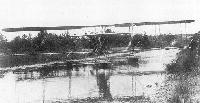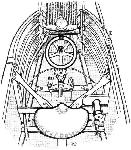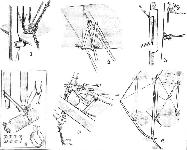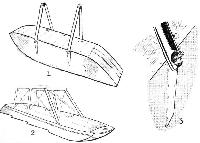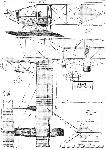P.Lewis British Aircraft 1809-1914 (Putnam)
Cody Hydro-biplane
The last and biggest of the Cody aeroplanes was designed and constructed for participation in the 1913 Circuit of Britain for the Daily Mail ?5,000 prize. As the race was around the coast, the machine was fitted with floats, a large one with three steps being mounted centrally accompanied by a smaller pair inboard below the lower wings.
Three-bay unstaggered wings of the usual Cody type were used, the upper set being slightly greater in span than the lower. Warping provided lateral control, and a one-piece frontal elevator of generous area was operated by a bamboo push-rod. The tail surfaces comprised the rudder, which was pivoted between the booms, and a small horizontal tailplane fixed to it. Tandem seats were used for the pilot and passenger and were, as usual in Cody's aeroplanes, of the metal farm-machinery type. The pilot's control-column and wheel operated all of the control surfaces; his feet were used for the ignition and accelerator pedals.
Cody chose the reliable 100 h.p. Green engine to propel the machine, and fitted it with a four-bladed Garuda propeller of 10 ft. 8 ins. diameter driven by a chain.
The machine was completed by the middle of July, 1913, and underwent its flotation tests on the Basingstoke Canal at Mytchett, Hants. In order to give it thorough flight trials, the floats were removed and a wheel and skid undercarriage was installed. On 7th August, 1913, Britain lost one of its greatest and most courageous flying pioneers when Cody and his passenger, W. H. B. Evans, were killed when they were flung out of the aircraft following an airframe breakage in mid-air.
SPECIFICATION
Description: Two-seat pusher hydro-biplane. Wooden structure, fabric covered.
Manufacturer: S. F. Cody, Laffan's Plain, Farnborough, Hants.
Power Plant: 100 h.p. Green.
Dimensions: Span, 59 ft. 6 ins. Length, 40 ft. 9 ins. Wing area, 770 sq. ft.
Performance: Maximum speed, 70 m.p.h. approx.
Показать полностью
M.Goodall, A.Tagg British Aircraft before the Great War (Schiffer)
Deleted by request of (c)Schiffer Publishing
CODY biplane No.VIA and B (Water-plane)
The last Cody aeroplane to be constructed was built to compete in the Daily Mail Seaplane Circuit of Britain, due to start from Calshot in August 1913. It was completed in July and was taken to Eelmoor Flash on the Basingstoke Canal for flotation trials. Thereafter the floats were removed and a wheel undercarriage fitted for flight trials. These included flying the machine to Brooklands on 3 August 1913 for the meeting on Sunday before the Bank Holiday. Cody planned to fly the machine to Calshot on Thursday 7 August for the floats to be fitted. However, in the morning he arranged to take up passengers and while he was flying with W.H.B. Evans, the Hampshire cricket captain, the machine broke up over Ball Hill near Cove and both Cody and his passenger fell to their deaths.
No.VI was the largest Cody aircraft, and had warping wings and a single front elevator. A large diamond shaped rudder pivoted between the booms and carried a small fixed triangular tailplane. Two seats were fitted in tandem, the pilot's controls and the chain driven propeller were similar to those on previous types. An enclosure to protect the crew was provided after the machine's early appearances.
No.VIA The narrow track land undercarriage incorporated a central skid serving as a front buffer and rear support. Sprung skids pivoted at the wing leading edge below the intermediate interplane struts prevented contact of the lower wingtips with the ground.
No.VIB The machine never flew as a seaplane, but the flotation gear consisted of a large three stepped central float with fabric decking. The balancing floats were fitted below the first set of interplane struts. These three floats were made by Harmsworth's Boatyard of Ash Vale, constructors of barges and boats, and were tested by being towed along the canal.
Power: 100hp Green six-cylinder inline water-cooled driving by chain a 10ft 8in diameter four-bladed Garuda propeller. A four-bladed Integral was due to be fitted.
Data
Span 59ft 6in
Chord 6ft 10in
Gap 8ft
Area 770 sq ft
Area Elevators 75 sq ft
Area Rudders 40 sq ft
Area Damper tailplane 25 sq ft
Length 40ft 9in
Height 12ft 9in
Speed range 45-70 mph
CODY PROJECTS
In 1913 Cody considered establishing his own company for producing aircraft in greater numbers. A catalogue of types was produced in which were listed the No.III biplane and No.IV monoplane, which had been built. In addition there were a smaller and a larger version of No.III, of which there were no sales and these remained unbuilt. The following is the estimated data extracted from the catalogue.
Data 30-35hp
Weight 750 lb without fuel or pilot
Lifting surface 400 sq ft
Width 35ft
Depth, fore and aft 25ft
Height overall 9ft 6in
Test flight 1hr
Speed range 35-45 mph
Gliding angle 1 in 7
Weight carrying 300 lb
Angle of ascent after 100 yard run on level ground
First 50 yd 1 in 7
Next 100 yd 1 in 10
Next mile 1 in 30
Price ?750
Data 50-60hp
Weight 1300 lb without fuel or pilot
Lifting surface 450 sq ft
Width 40ft
Depth, fore and aft 30ft
Height overall lift
Test flight Ihr
Speed range 40-58 mph
Gliding angle 1 in 6.5
Weight carrying 800 lb
Angle of ascent after 100 yard run on level ground
First 50 yd 1 in 6
Next 100 yd 1 in 9
Next mile 1 in 25
Price ?1,000
Data 100-160hp
Weight 1850 lb without fuel or pilot
Lifting surface 500 sq ft
Width 45ft
Depth, fore and aft 35ft
Height overall 12ft 6in
Test flight 1hr
Speed range 50-75 mph
Gliding angle 1 in 5
Weight carrying 1,000lb
Angle of ascent after 100 yard run on level ground
First 50 yd 1 in 4
Next 100 yd 1 in 6
Next mile 1 in 20
Price ?1,200 to ?1,800
The above details referred to the ordinary types of 'Touring Machines'. Specifications of 50-60hp and 100-160hp 'Special Racing Types' were available on application.
CODY monoplane No.VII (Transatlantic)
In April 1913 the Daily Mail offered a ? 10,000 prize for a Transatlantic flight, a challenge which Cody intended to accept. He planned to build a monoplane of 120ft span, mounted on twin floats and with a crew of three. For this venture he required a 400hp engine. He prepared a specification for a large twelve-cylinder engine and passed drawings and ?600 deposit to a French company to manufacture. This was abandoned after his death.
Показать полностью
Журнал Flight
Flight, July 19, 1913.
BRITISH NOTES OF THE WEEK.
The New Cody Biplane.
LAST week-end Col. Cody was testing the new biplane, which he has built with the intention of competing in the Daily Mail race round Britain. In general design the biplane is similar to that which won the military competition, but it is larger, and has only one cruciform tail. The 100 h.p. engine drives a four-bladed Garuda propeller. A central skid with an upturned tusk in front is fitted, and skids are arranged under the outward sections of the main planes to take the place of the wheels which were formerly mounted at the wing tips. When the machine has, been thoroughly tested it will be fitted with three floats with which Col. Cody has been conducting trials on the Basingstoke Canal.
Flight, August 9, 1913.
BRITISH NOTES OF THE WEEK.
Death of Col. Cody.
IT is with the deepest regret that we have to record that the news reaches us as we go to press that Col. Cody, while flying at Aldershot on Thursday morning with a passenger named Evans, met with an accident and was killed, together with his passenger.
Flight, August 16, 1913.
THE CODY WATERPLANE.
No doubt most of our readers will agree that in no better way could we honour the name of the great pioneer, than by publishing illustrations and particulars of the latest machine built by the late Col. S. F. Cody for the Daily Mail race round Britain, the machine in which he had incorporated all the improvements that his great experience and ever-alert inventive genius had suggested to him, and of which his opinion - as expressed by himself a short time before his death - was that she was "A beauty, and as steady as a rock." We believe that the scale drawings and sketches of the Cody Waterplane, which we publish herewith, and which were made a few days before Mr. Cody's death, are the only complete drawings available of the ill-fated machine, and they should therefore be of exceptional value to all who have followed with interest the work of the great pioneer.
Size and weight have always been the characteristics of Cody machines, and it was only to be expected that for a contest like the Daily Mail Round Britain Race, which will impose upon both pilot and machine much more severe strains than any to which aeroplanes have hitherto been subject that these characteristics would be retained, and as regards dimensions and weight the Cody is far in excess of any of the other machines entered. In this latest machine the span of the main planes has been considerably increased, while the overall length has been greatly reduced by bringing both the front elevator and the rudder closer in towards the main planes. It will be remembered that the machine on which Mr. Cody won first prize in the Military Competition last year had two rudders of cruciform shape. In the present machine only a single rudder is fitted, which has consequently had to be made of much larger area, situated, as it is, closer to the main planes, and therefore working on a smaller leverage. One of the features of the earlier Cody biplanes has disappeared, i.e., the divided front elevator, which worked in conjunction with the main planes for maintenance of lateral stability. In its stead is fitted an elevator of more orthodox type, which has a slot cut in the centre for the accommodation of the central elevator booms. These, as well as the tail outriggers are made of bamboo bound with fabric. The nacelle is of a slightly different form to last year's model, providing better accommodation for the pilot's and passenger's seats, which are placed tandem fashion, and which are still of the type more commonly associated with farm implements. A 100 h.p., 6-cyl., all-British Green engine, furnishes the power, and drives through chain and sprocket gearing a propeller of 10 ft. 8 ins. diameter. For experimental purposes a four-bladed Garuda propeller was fitted, which was exchanged later for one of British manufacture (the latter being on the machine when the mishap occurred). The petrol tank, which has a capacity of 60 gallons, is situated above and behind the passenger's seat, while a supply of 14 gallons of oil is carried in a smaller tank situated underneath the engine.
Eight pairs of struts of silver spruce connect the main planes, which are of the typical Cody section, characterized by a deeper camber on the underside of the wing than that on the top. For maintenance of lateral stability, the main planes are warped by moving the control lever from side to side. A to and fro movement of the steering column operates the elevator, whilst rotation of the hand wheel actuates the rudder. It will thus be seen that the feet of the pilot do not perform any function in the control of the machine, and are therefore left free to operate the accelerator and ignition pedals fitted on the floor board of the nacelle. An interesting feature, and one that is not generally known in connection with the Cody control, is that the rudder works in conjunction with the warp, so that in correcting a bank the rudder is put over just sufficiently to counteract the drag on the lower side without any necessity for turning the handwheel.
For use as a land machine, a chassis of somewhat modified form to that of the earlier types is fitted, it having been designed with a view to facilitate interchangeability with floats, and in the accompanying scale drawings we show both types of chassis. The floats, of which there are three, are of Mr. Cody's own design, from which he expected excellent results, but which, unfortunately, he never got a chance to fully test. The main or central float, which is of enormous size, has three steps of peculiar design, while the two smaller floats are of the plain or punt shape. While the smaller floats are situated higher up than the main floats, they are still sufficiently far down to be always in contact with the water until the machine is just about to rise, so that it will be very stable when at rest or taxying on the water. Cedar and mahogany are the materials used in the construction of the floats, the main float being provided with a canvas deck. The speed of the machine is 50 to 60 m.p.h., and the weight, when empty and fitted with the land chassis, is about a ton.
Показать полностью



